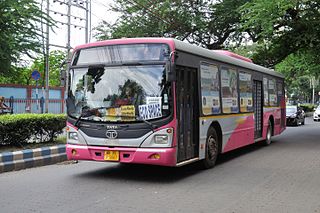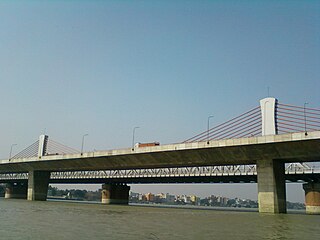
A cable-stayed bridge has one or more towers, from which cables support the bridge deck. A distinctive feature are the cables or stays, which run directly from the tower to the deck, normally forming a fan-like pattern or a series of parallel lines. This is in contrast to the modern suspension bridge, where the cables supporting the deck are suspended vertically from the main cable, anchored at both ends of the bridge and running between the towers. The cable-stayed bridge is optimal for spans longer than cantilever bridges and shorter than suspension bridges. This is the range within which cantilever bridges would rapidly grow heavier, and suspension bridge cabling would be more costly.

The Millau Viaduct is a multispan cable-stayed bridge completed in 2004 across the gorge valley of the Tarn near Millau in the Aveyron department in the Occitanie Region, in Southern France. The design team was led by engineer Michel Virlogeux and English architect Norman Foster. As of October 2023, it is the tallest bridge in the world, having a structural height of 336.4 metres (1,104 ft).

Howrah is a district in the Indian state of West Bengal. Howrah city is located on the western bank of the Hooghly River. Administratively Howrah city lies within Howrah district, and is the headquarters of the Howrah Sadar subdivision. It is also part of the Kolkata Metropolitan Area, with development from the Kolkata Metropolitan Development Authority. Howrah city is an important transportation hub and suburb of Kolkata. It is also a gateway to old Kolkata via Howrah railway station and Howrah Bridge.

The Hooghly River or popularly called Ganga or Kati-Ganga in the Puranas, is a river that rises close to Giria, which lies north of Baharampur and Palashi in Murshidabad. It is the western distributary of the Ganges. The main course of the Ganges then flows into Bangladesh as the Padma. A man-made canal, built in the 1960s and early-1970s at Farakka, connects the Ganges, flowing through Malda, to the Hooghly to bring the abundant waters of the Himalayan river to the comparatively narrow river that rises in eastern West Bengal.

Shibpur or Sibpur is a neighbourhood in Howrah city of Howrah district in the Indian state of West Bengal. It is a part of the area covered by Kolkata Metropolitan Development Authority (KMDA).

The Howrah Bridge is a balanced steel bridge over the Hooghly River in West Bengal, India. Commissioned in 1943, the bridge was originally named the New Howrah Bridge, because it replaced a pontoon bridge at the same location linking the twin cities of Howrah and Kolkata, which are located at the opposite banks of each other. On 14 June 1965, it was renamed Rabindra Setu after the Bengali poet Rabindranath Tagore, who was the first Indian and Asian Nobel laureate. It is still popularly known as the Howrah Bridge.

Vivekananda Setu is a bridge over the Hooghly River in West Bengal, India. It links the city of Howrah, at Bally, to Kolkata, at Dakshineswar. Completed in 1931, it is a multispan truss bridge that was built to primarily to provide direct road and rail connectivity between the Calcutta Port and the major railhead at Howrah railway station on the West bank of the Hooghly River. It is 2,887 feet (880 m) long having 9 spans in total. The famous Dakshineswar Kali Temple is situated on the banks of the Hooghly River near the bridge. The bridge is one of the four bridges linking Howrah and Kolkata. A new road bridge, the Nivedita Setu, was constructed 50 m (160 ft) downstream in 2007 due to weakening of the Vivekanada Setu caused by its ageing.
Mahatma Gandhi Setu is a bridge over the river Ganges in Bihar, India, connecting Patna in the south to Hajipur in the north. Its length is 5,750 metres (18,860 ft) and it is the third-longest river bridge in India. It was inaugurated in May 1982 in a ceremony in Hajipur by the then prime minister, Indira Gandhi. From 1982 to 2017, Mahatma Gandhi Setu remained as the longest bridge in India. Later, Gandhi Setu rehabilitation project was undertaken to install triangular steel trusses on Mahatma Gandhi Setu.

An extradosed bridge employs a structure that combines the main elements of both a prestressed box girder bridge and a cable-stayed bridge. The name comes from the word extrados, the exterior or upper curve of an arch, and refers to how the "stay cables" on an extradosed bridge are not considered as such in the design, but are instead treated as external prestressing tendons deviating upward from the deck. In this concept, they remain part of the main bridge superstructure.

The Bandra-Worli Sea Link is a 5.6 km long, 8-lane wide cable-stayed bridge that links Bandra in the Western Suburbs of Mumbai with Worli in South Mumbai. It is the longest sea bridge, as well as the 5th longest bridge in India after Mumbai Trans Harbour Link, Bhupen Hazarika Setu, Dibang River Bridge and Mahatma Gandhi Setu. It contains pre-stressed concrete-steel viaducts on either side. It was planned as a part of the proposed Western Freeway that would link the Western Suburbs to Nariman Point in Mumbai's main business district, but is now planned to become part of the Coastal Road to Kandivali.

The transport system of Kolkata, a city in India, is a mix of modern mass rapid transport and old transport modalities like rickshaws. Kolkata is connected to the rest of India by the National Highways, the extensive network of the Indian Railways, National Waterways and by air. The most traffic to Northeast India route is via Kolkata.

Bally is a neighbourhood in the city of Howrah of Howrah district in the Indian state of West Bengal. It is a part of the area covered by Kolkata Metropolitan Development Authority (KMDA).

The Braithwaite Burn & Jessop Construction Company Limited is a Public Sector Undertaking (PSU) of the Government of India under Department of Heavy Industries. Established on 26 January 1935, BBJ Construction Company has been involved in the construction & repairing of Rail Bridges & Rail-cum-Road Bridges, Industrial structural works, Large building foundation, Civil engineering works, Refinery piping works, Railway gauge conversion etc. The company is registered and headquartered in Kolkata.

Nivedita Setu is a multi-span extradosed bridge that was built over Hooghly River connecting Howrah with Kolkata,West Bengal. It runs parallel to and about 50 m downstream of the old Vivekananda Setu opened in 1932. The bridge is named after Sister Nivedita, the social worker-disciple of Swami Vivekananda. Belghoria Expressway that connects the meeting point of NH 16 with NH 19 at Dankuni to NH 12, NH 112, Dumdum/Kolkata Airport and northern parts of Kolkata passes over the bridge. The bridge is designed to carry 48,000 vehicles per day.
The Hooghly River Bridge Commissioners (HRBC) office is a statutory organization under the Department of Transport, established in 1969 for the construction of Vidyasagar Setu.

The Sudarshan Setu is a cable-stayed bridge in India, connecting the Beyt Dwarka island in the Gulf of Kutch and Okha. The total length of the bridge is 2,320 metres (7,612 ft). It was inaugurated on 25 February 2024.
New Zuari Bridge, also commonly known as Manohar Setu, is a bridge over the Zuari River in Goa, India, linking the districts of North Goa and South Goa.
The Second Ishwar Gupta Setu is an under-construction extradosed cable-stayed bridge spanning the Hooghly River, connecting Kalyani in Nadia district with Bansberia in Hooghly district. The bridge is being constructed to the design of Rail India Technical and Economic Services. It is part of Kalyani Expressway.






















